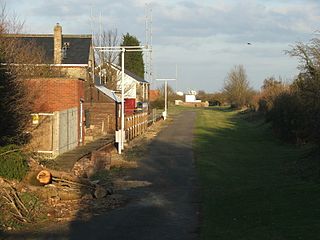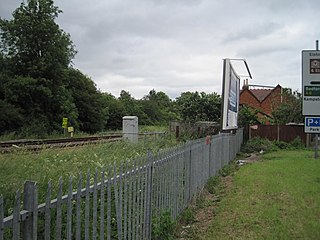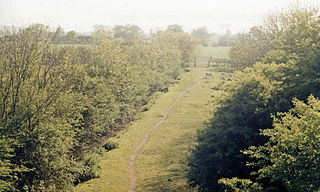
The Varsity Line was the main railway route that once linked the English university cities of Oxford and Cambridge, operated by the London and North Western Railway.

Stewartby is a model village and civil parish in Bedfordshire, originally built for the workers of the London Brick Company. The village was designed and built to the plans of the company's architect Mr F W Walker, laid out on ‘Garden City’ principle, a later and more modern development than such better-known Victorian model villages as Saltaire. Started in 1926, Stewartby also is a later model than Woodlands which was first planned in 1905. The later retirement bungalow development of the 1950s and 1960s with the pavilion community centre in their midst was designed by the neo-Georgian architect Professor Sir Albert Richardson. Today, Stewartby parish also includes Kempston Hardwick.

Stewartby railway station is a station on the London Northwestern Railway, which serves the Bedfordshire village of Stewartby in England. It is the nearest station to the Marston Vale Millennium Country Park.

Kempston Hardwick railway station serves the village of Kempston Hardwick in Bedfordshire, England. It should not be confused with the nearby town of Kempston. The station has two platforms next to a half-barrier level crossing.

Meyrick Park Halt was a railway halt located in the Meyrick Park area of Bournemouth, just west of Bournemouth Central railway station in the county of Hampshire in England. It opened in 1906 as a response to competition from street-running tramways, and served a growing suburb of Bournemouth as well as leisure activities.

Lord's Bridge was a railway station on the Varsity Line which ran between Oxford and Cambridge. Situated in the north of the parish of Harlton on the western outskirts of Cambridge, it was the penultimate station before the line's eastern terminus at Cambridge. The station opened in 1862 and closed more than a century later in 1968. The site is now part of the Mullard Radio Astronomy Observatory, which includes several rail-mounted radio-telescopes.

Bingham Road railway station was in Addiscombe, Croydon on the Woodside and South Croydon Joint Railway. It was opened on 1 September 1906 on the north side of Bingham Road, with two wooden platforms without buildings and was closed on 15 March 1915 as a wartime economy measure. A new station on the south side of Bingham Road was opened in 1935 and finally closed in 1983. The modern Addiscombe tram stop at ground level is situated at the location of the first halt closed in 1915 which was situated on an embankment above the present site.
Girtford Halt was a short-lived railway halt on the Varsity Line which served the hamlet of Girtford near Sandy in Bedfordshire, England. It was opened by the London, Midland and Scottish Railway in 1938, but closed to passenger traffic two years later in 1940. The line itself closed in 1968, and the site of the railway station has been obliterated by a roundabout.
Willington was a railway station on the Varsity Line which served the small village of the same name in Bedfordshire. Opened in 1903, the station was located in a rural area and saw little passenger traffic; it closed together with the line in 1968.

Fotherby Halt was a railway halt on the East Lincolnshire Railway which served the village of Fotherby in Lincolnshire between 1905 and 1961. The station was opened on the site of a previous station named Fotherby Gate House which had closed in 1872. The second station closed in 1961, but the line through it remained open for freight until December 1980. The line through the station could be reopened by the Lincolnshire Wolds Railway as part of its extension south from Ludborough to Louth.

Oxford Road Halt was a railway station on the Varsity Line 1 mile (1.6 km) west of the hamlet of Water Eaton, Oxfordshire.

Kempston & Elstow Halt was a railway station on the Varsity Line which served the Bedfordshire town of Kempston in England. Opened in 1905, it was closed temporarily during both world wars and did not reopen after 1941, being officially closed in 1949.

Cassington Halt was a single platform halt opened by the Great Western Railway on 9 March 1936 on the Oxford, Witney and Fairford Railway to serve the village of Cassington, Oxfordshire, just south of the A40.

Yarnton Junction was a three-platform station serving the village of Yarnton, Oxfordshire. It was built in 1861 at the junction of the Oxford, Worcester and Wolverhampton Railway and Witney Railway, north of Oxford. British Railways closed the station to passengers in 1962 and it was demolished c. 1965.

Eynsham railway station served the Oxfordshire town of Eynsham and the Eynsham Sugar Beet Factory on the Oxford, Witney and Fairford Railway between Oxford and Witney.

Chambers Crossing Halt railway station was a timber-framed railway halt on the Stratford-upon-Avon to Cheltenham section of the Honeybourne Line. The station was located two miles south-west of Stratford upon Avon. The site of the station is now part of the Stratford greenway and may in future form part of the Gloucestershire Warwickshire Railway's northern extension from Toddington.
Laverton Halt railway station was a halt on the Honeybourne Line from Honeybourne to Cheltenham which served the hamlet of Laverton in Gloucestershire between 1905 and 1960.

Grainsby Halt was a railway halt on the East Lincolnshire Railway which served the hamlet of Grainsby in Lincolnshire between 1905 and 1952. The station, which opened as part of a new motor train service between Grimsby and Louth, was opened to serve a Victorian hall situated 2 miles (3.2 km) to the west. The station, one of the smallest to be taken over by British Railways on nationalisation in 1947, never really justified its existence and closed in 1952 following a period of temporary closure during the Second World War. The line through Grainsby remained open for freight until December 1980.
Weelsby Road Halt was a railway halt on the East Lincolnshire Railway which served the Weelsby Road area of eastern Grimsby in Lincolnshire between 1905 and 1940. The station was opened as part of a new motor train service between Grimsby and Louth. It was the site of major works in 1933 when a plate girder bridge was constructed to replace a level crossing, enabling road traffic to pass underneath through a subway. The station closed in 1952 following a period of temporary closure during the Second World War. The line through Weelsby remained open for freight until December 1980. The trackbed was later reused by Humberside County Council to construct the A16 Peaks Parkway which now runs through the site. Building of the road put an end to the aspirations of the Great Northern and East Lincolnshire Railway plc to reopen the line as a heritage railway.
Hainton Street Halt was a railway halt on the East Lincolnshire Railway which served the Welholme Road area of Grimsby in Lincolnshire between 1905 and 1961. The station was opened as part of a new motor train service between Grimsby and Louth. The station briefly closed in 1939 as a Second World War economy measure, but reopened in 1940. The line through Hainton Street remained open for freight until December 1980. The trackbed was later reused by Humberside County Council to construct the A16 Peaks Parkway which now runs through the site. Building of the road put an end to the aspirations of the Great Northern and East Lincolnshire Railway plc to reopen the line as a heritage railway.















